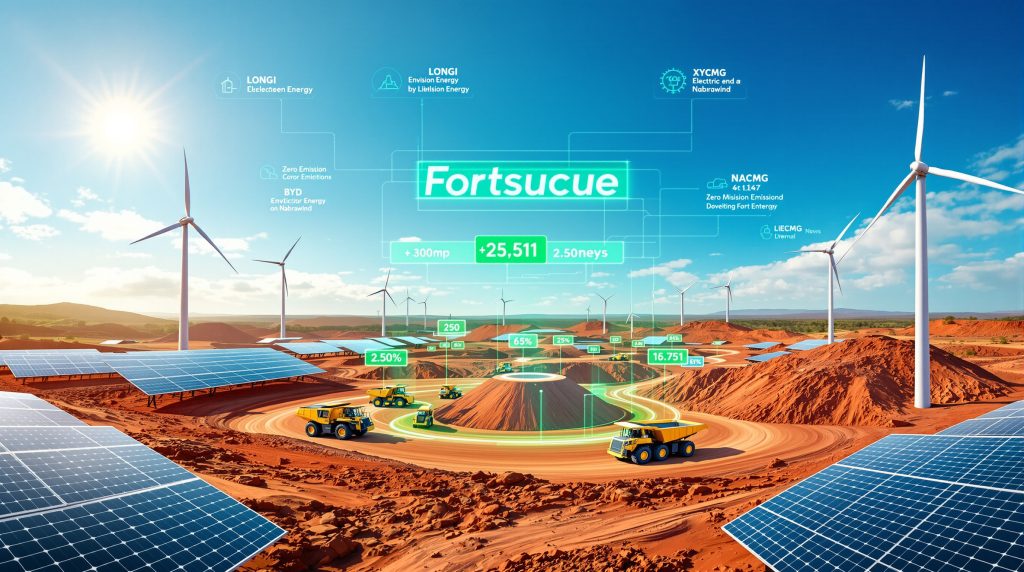Fortescue's Global Decarbonisation Strategy: Building Partnerships for a Zero-Emissions Future
Fortescue Metals Group has positioned itself at the forefront of mining industry decarbonisation through a strategic network of global partnerships. The company's approach represents a significant shift in how resource companies address climate challenges, emphasizing practical implementation over aspirational targets. By aligning with technology leaders across continents, Fortescue is creating a blueprint for how heavy industry can simultaneously reduce emissions and enhance profitability.
These collaborative efforts build upon Fortescue's recently updated Climate Transition Plan, providing the technological foundation required to transform mining operations while maintaining productivity and shareholder value. The partnerships span multiple continents and technological domains, creating a comprehensive ecosystem for innovation and implementation.
How Is Fortescue Advancing Its Decarbonisation Agenda?
Fortescue has significantly expanded its global decarbonisation partnerships by formalizing agreements with renewable energy and clean technology innovators worldwide. This strategic move positions the mining giant as an industry leader in practical climate action rather than merely setting ambitious targets.
The company's approach focuses on creating tangible pathways to emissions reduction through technology adoption and integration. By partnering with established manufacturers and technology developers, Fortescue gains access to proven solutions that can be scaled and implemented across its extensive operations.
Executive Chairman Andrew Forrest has emphasized that this strategy demonstrates how "profits rise as emissions fall," highlighting the alignment between environmental responsibility and business performance. This perspective challenges the traditional view that decarbonisation economic benefits necessarily come at the expense of financial returns.
The partnerships are designed to address multiple aspects of mining operations simultaneously, from fleet electrification to renewable energy generation and storage. This comprehensive approach ensures that emissions reduction efforts permeate throughout Fortescue's value chain.
Who Are Fortescue's Key Decarbonisation Partners?
Strategic Technology Collaborations
Fortescue has established a diverse network of partnerships with global technology leaders, each bringing specialized expertise to the company's decarbonisation efforts:
-
BYD: The Chinese electric vehicle and battery manufacturer will support Fortescue's mining fleet electrification initiatives and provide energy storage solutions. BYD's expertise in battery technology will be crucial for the transition from diesel-powered equipment.
-
LONGi: This solar technology developer will deliver high-efficiency photovoltaic solutions for Fortescue's renewable energy infrastructure. LONGi's advanced solar panels offer improved energy capture, essential for powering remote mining operations.
-
XCMG: The construction and mining equipment manufacturer will collaborate on developing zero-emission heavy machinery specifically designed for mining applications. This partnership addresses one of the most challenging aspects of mining industry innovation.
-
Envision Energy: This wind and energy storage specialist will implement integrated renewable power solutions across Fortescue's operations. Envision's expertise in grid integration will help ensure reliable power supply despite the intermittent nature of renewable sources.
European Manufacturing Alliance
Fortescue's partnership network extends beyond Asia to include European technology leaders:
-
Liebherr: The European equipment manufacturer continues its established role in Fortescue's decarbonisation ecosystem, focusing on transforming the mining fleet with more efficient and lower-emission machinery.
-
Nabrawind: Fortescue recently completed the acquisition of this Spanish renewable technology company, enhancing its wind energy capabilities with innovative turbine designs specifically suited for industrial applications.
These partnerships represent a truly global approach to industrial decarbonisation, bringing together expertise from Europe, Asia, and Australia to address climate challenges through practical technology implementation.
What Makes Fortescue's Decarbonisation Approach Unique?
Multilateral Collaboration Model
Fortescue's partnership network represents a departure from traditional corporate approaches to climate action. Rather than relying solely on in-house development or single-vendor solutions, the company has created a diverse ecosystem of technology providers.
This multilateral approach allows Fortescue to leverage specialized expertise across multiple domains while maintaining a coherent overall strategy. By bringing together technology leaders from different continents, the company is fostering cross-border innovation that can overcome regional limitations.
As Andrew Forrest noted in a recent statement to The Globe and Mail, "This is a truly multilateral collaboration that draws on the best ideas and manufacturing capacity to deliver the lowest cost energy and tackle climate change." This perspective emphasizes how industrial cooperation can transcend geopolitical tensions to address shared environmental challenges.
Practical Implementation Focus
Unlike many corporate climate initiatives that focus primarily on long-term targets, Fortescue's strategy emphasizes immediate practical implementation of available technologies. This approach acknowledges the urgency of climate action while recognizing that solutions must be commercially viable to achieve widespread adoption.
The company's partnerships are designed to deliver tangible emissions reductions in the near term while establishing pathways for continued improvement. This balance between ambition and practicality distinguishes Fortescue's approach from more aspirational but less actionable climate commitments.
Furthermore, by demonstrating that decarbonisation can enhance rather than undermine financial performance, Fortescue is creating a compelling business case for sustainable mining transformation across the industry. This may accelerate adoption of similar approaches by competitors seeking to maintain market position.
How Does This Strategy Connect to Fortescue's Climate Transition Plan?
Fortescue's partnership network serves as the implementation mechanism for its broader Climate Transition Plan. The technologies being developed and deployed through these collaborations directly address the key emissions sources identified in the plan, creating a clear path from commitment to action.
The partnerships provide Fortescue with access to established technologies that can be rapidly deployed across its operations, accelerating the timeline for emissions reduction. This approach minimizes implementation risks while maximizing near-term impact.
Moreover, by engaging with multiple technology providers, Fortescue creates competitive tension that can drive innovation and cost reduction. This strategy helps ensure that decarbonisation efforts remain economically viable even as they scale across the company's extensive operations.
The diverse nature of the partnerships also provides redundancy and resilience, allowing Fortescue to adapt its approach as technologies evolve and new solutions emerge. This flexibility is crucial given the rapidly changing landscape of clean energy and energy transition strategies.
What Business Benefits Does Fortescue Expect from Decarbonisation?
Competitive Advantage
Fortescue's early leadership in mining decarbonisation positions the company to meet evolving market expectations for responsibly produced resources. As consumers, investors, and regulators increasingly focus on supply chain emissions, this proactive stance may create significant competitive advantages.
The company's partnerships with leading technology providers also give it privileged access to innovations that may not be immediately available to competitors. This technology advantage could translate into operational efficiencies and cost reductions that enhance Fortescue's market position.
Furthermore, by establishing itself as a pioneer in industrial sustainability, Fortescue may strengthen its relationships with customers who face their own pressure to reduce scope 3 emissions. This alignment of values throughout the supply chain could lead to preferential sourcing arrangements and price premiums.
Operational Efficiency
Many of the technologies being implemented through Fortescue's partnership network offer operational benefits beyond emissions reduction. Electrified mining equipment, for example, typically requires less maintenance than diesel alternatives, potentially reducing downtime and extending asset lifespans.
Renewable energy systems, once installed, provide power at predictable costs unaffected by fuel price volatility. This improved cost certainty can enhance financial planning and risk management, particularly in an era of increasing carbon pricing mechanisms.
The digitalization that often accompanies clean technology implementation may also provide valuable operational insights through enhanced data collection and analysis. These insights could lead to process optimizations that further improve efficiency and reduce costs.
Global Leadership Position
Through its comprehensive partnership approach, Fortescue is establishing itself as an influential voice in global discussions about industrial decarbonisation. This leadership position may provide intangible benefits in terms of regulatory influence, talent attraction, and social license to operate.
As Andrew Forrest emphasized in Fortescue's official announcement, the company is "showing that industry can help glue back that multilateral spirit" at a time of global division. This positioning aligns Fortescue with broader societal goals, potentially enhancing its reputation and influence in international markets.
By demonstrating practical pathways to industrial decarbonisation, Fortescue may also influence policy development and technology standards in ways that align with its strategic interests. This proactive engagement with the energy transition represents a sophisticated approach to managing long-term business risks.
How Will These Partnerships Transform Fortescue's Operations?
Mining Fleet Electrification
Working with partners like BYD and XCMG, Fortescue is accelerating the replacement of diesel-powered mining equipment with zero-emission alternatives. This transformation targets one of the largest sources of direct emissions in mining operations while potentially reducing fuel and maintenance costs.
The electrification initiative includes both heavy mobile equipment and light vehicles, creating a comprehensive approach to fleet decarbonisation. By addressing multiple vehicle classes simultaneously, Fortescue can maximize emissions reduction while developing the supporting infrastructure in an integrated manner.
The partnership with BYD specifically enables Fortescue to leverage world-leading battery technology and manufacturing scale, potentially reducing the cost premium traditionally associated with electric vehicles. This economic advantage could accelerate adoption timelines and improve return on investment.
Renewable Energy Integration
Collaborations with LONGi, Envision Energy, and Nabrawind enhance Fortescue's capacity to generate and utilize renewable power across its operations. These partnerships address the challenge of powering energy-intensive mining processes with intermittent renewable sources through innovative generation and storage solutions.
The acquisition of Nabrawind provides Fortescue with proprietary wind turbine technology specifically designed for industrial applications, potentially offering advantages in terms of deployment speed and performance optimization. This vertical integration in renewable technology represents a strategic investment in long-term energy security.
By combining solar, wind, and energy storage technologies, Fortescue can create hybrid power systems that maximize renewable penetration while maintaining reliability. This integrated approach addresses one of the key barriers to renewable adoption in mining operations: the need for continuous power availability.
Technology Innovation
These partnerships extend beyond simple procurement relationships, creating opportunities for joint technology development. By combining Fortescue's operational expertise with its partners' technical capabilities, the collaborations could yield proprietary solutions offering long-term competitive advantages.
The cross-pollination of ideas across different technology domains and geographic regions may accelerate innovation cycles and lead to unexpected breakthroughs. This collaborative innovation ecosystem represents a strategic asset that could generate value beyond the immediate decarbonisation objectives.
Moreover, by working directly with manufacturers during the development phase, Fortescue can ensure that new technologies address the specific challenges of mining environments, from extreme temperatures to dust exposure and continuous heavy-duty operation. This tailored approach increases the likelihood of successful implementation.
What Challenges Must Fortescue Navigate?
Technology Integration
Implementing diverse technologies from multiple partners requires careful systems integration to ensure operational compatibility and reliability. Fortescue must develop robust frameworks for technology selection, testing, and deployment to maintain operational continuity during the transition.
The company faces the challenge of integrating new systems with existing infrastructure, particularly in remote mining locations with limited supporting services. This integration complexity necessitates comprehensive planning and potentially phased implementation to manage operational risks.
Furthermore, the rapid evolution of clean technologies creates the risk of stranded assets or obsolescence if investment decisions don't adequately account for future technological developments. Fortescue must balance early adoption with flexibility to incorporate emerging innovations.
Scale and Timeline
Achieving meaningful emissions reductions across Fortescue's extensive operations requires rapid scaling of new technologies. The company must coordinate multiple parallel initiatives while maintaining production targets and meeting customer commitments.
The global nature of the partnership network adds logistical complexity, as equipment and expertise must be coordinated across different time zones, regulatory environments, and cultural contexts. This coordination challenge requires sophisticated project management capabilities.
Additionally, the timeline for technology deployment must align with Fortescue's broader business cycles, including maintenance schedules, expansion plans, and market conditions. This alignment is crucial for minimizing disruption and optimizing capital allocation.
Investment Returns
While decarbonisation offers long-term benefits, Fortescue must balance substantial upfront investments with shareholder expectations for continued financial performance. The company needs to clearly articulate how these investments create value beyond emissions reduction to maintain investor support.
The innovative nature of many decarbonisation technologies creates uncertainty around implementation costs and performance outcomes. Fortescue must develop robust risk management strategies to address this uncertainty while maintaining progress toward its climate goals.
Moreover, the company faces the challenge of quantifying the financial benefits of climate leadership, including potential premium pricing, improved access to capital, and reduced regulatory risks. These intangible benefits are difficult to capture in traditional return calculations but may significantly impact the overall business case.
How Does This Approach Impact the Broader Mining Industry?
Setting New Standards
Fortescue's comprehensive partnership approach establishes a potential blueprint for other mining companies seeking to reduce emissions. By demonstrating that decarbonisation can be practically implemented at scale without compromising operational performance, Fortescue is shifting industry expectations around climate action.
The company's willingness to invest in emerging technologies may accelerate their commercialization, reducing costs and implementation barriers for subsequent adopters. This market development effect could benefit the entire industry by expanding the range of commercially viable decarbonisation options.
Furthermore, Fortescue's approach of embedding sustainability within core business strategy rather than treating it as a separate initiative represents an evolving best practice that may influence industry norms. This integration of environmental and financial objectives reflects a maturing understanding of climate risk.
Supply Chain Transformation
As a major industry player implements decarbonisation at scale, equipment manufacturers and service providers have strong incentives to accelerate their own clean technology development. This demand signal may drive innovation and competition in the mining supplier ecosystem.
Fortescue's partnership model demonstrates how mining companies can actively shape technology development through direct collaboration with manufacturers. This approach may inspire similar collaborative initiatives throughout the industry, accelerating the pace of innovation.
The focus on multiple aspects of the value chain—from energy generation to equipment operation—highlights the importance of comprehensive approaches to emissions reduction. This holistic perspective may encourage other mining companies to broaden the scope of their sustainability initiatives.
Regulatory Influence
Successful implementation of Fortescue's decarbonisation strategy could demonstrate the feasibility of more ambitious industry-wide emissions standards. By establishing practical pathways to significant emissions reduction, the company's approach may inform future regulatory frameworks.
The multilateral nature of Fortescue's partnerships also provides a model for how global climate challenges can be addressed through cross-border collaboration rather than fragmented national approaches. This cooperative framework may influence international climate policy development.
Additionally, by proactively exceeding current regulatory requirements, Fortescue is positioning itself advantageously for future policy changes. This forward-looking approach to compliance may become increasingly important as climate regulations evolve and strengthen.
FAQ: Fortescue's Decarbonisation Partnerships
What timeline has Fortescue established for its decarbonisation goals?
Fortescue has developed a detailed timeline within its Climate Transition Plan, with specific milestones for emissions reduction across different operational areas. The technology partnerships are strategically aligned with these milestones to ensure timely implementation.
The company has acknowledged that decarbonisation is a journey rather than a destination, with continuous improvement expected as technologies evolve. This perspective balances ambitious targets with practical implementation considerations.
While specific timeline details require verification against Fortescue's official communications, the partnerships announced clearly indicate an acceleration of decarbonisation efforts compared to previous industry norms.
How do these partnerships align with Fortescue's broader business strategy?
The fortescue decarbonisation partnerships represent a core element of Fortescue's strategy to maintain industry leadership through innovation and sustainability. By addressing climate challenges proactively, the company is positioning itself for long-term success in an evolving market environment.
These collaborations also support Fortescue's efforts to diversify beyond traditional mining activities, potentially opening new business opportunities in clean energy and technology. This strategic broadening reflects an understanding of how the global energy transition may reshape resource markets.
Furthermore, the partnerships demonstrate Fortescue's commitment to stakeholder capitalism, addressing the interests of communities, employees, and future generations alongside shareholder returns. This balanced approach to value creation aligns with evolving expectations for corporate responsibility.
What role does innovation play in Fortescue's decarbonisation approach?
Innovation forms the cornerstone of Fortescue's strategy, with the fortescue decarbonisation partnerships providing access to cutting-edge technologies that can be adapted and optimized for mining applications. The company recognizes that existing solutions alone cannot achieve the scale of emissions reduction required.
By engaging directly with technology developers, Fortescue can influence innovation priorities to address specific mining challenges. This collaborative approach ensures that new technologies are designed with practical implementation considerations in mind.
The diverse nature of the partnership network creates opportunities for cross-domain innovation, where advances in one area (such as battery technology) can inform developments in others (such as mobile equipment design). This ecosystem approach maximizes the potential for breakthrough solutions.
Conclusion: Fortescue's Collaborative Path to Mining Decarbonisation
Fortescue's expanded network of decarbonisation partnerships represents a significant advancement in the mining industry's approach to emissions reduction. By bringing together diverse technology leaders from around the world, the company is creating a practical pathway for implementing its ambitious climate goals while maintaining operational excellence.
The multilateral collaboration model demonstrates how industry can lead in addressing climate challenges through cooperation rather than competition. This approach not only supports Fortescue's environmental objectives but also positions the company for continued success in a rapidly evolving global market that increasingly values sustainable production methods.
Through these strategic alliances, Fortescue is transforming abstract climate commitments into tangible operational changes, potentially establishing new industry standards for environmental performance. The company's emphasis on practical implementation over rhetoric provides a blueprint for how heavy industry can navigate the energy transition while generating shareholder value.
As Executive Chairman Andrew Forrest has emphasized, this approach shows that "profits rise as emissions fall," challenging the traditional view that environmental responsibility necessarily comes at the expense of financial performance. By aligning economic and environmental objectives, Fortescue is demonstrating leadership that may influence the broader business community beyond the mining sector.
Disclaimer: This article discusses future business strategies and potential outcomes which inherently involve uncertainties. Readers should consult Fortescue's official communications and financial disclosures for the most current information on the company's fortescue decarbonisation partnerships and initiatives.
Want to Discover the Next Major ASX Mining Opportunity?
Stay ahead of the market with Discovery Alert's proprietary Discovery IQ model that instantly notifies you about significant mineral discoveries on the ASX, turning complex data into actionable investment insights. Visit the dedicated discoveries page to understand how major mineral finds can generate substantial returns for early investors.




